This post may include affiliate links. Thank you for your support.
Learn how to make the best Chestnut Stuffing with 9 simple ingredients! Featuring sweet cornbread, meaty sausage and rich roasted chestnuts, along with tender vegetables and plenty of fresh herbs, this recipe for Thanksgiving stuffing with chestnuts is bursting with robust flavors. Whether you call it stuffing or dressing, this homemade Thanksgiving side dish is a million times better than what you get from a box – and, it’s easy to make!
Featured comment: We followed your easy, pictures included, step by step instructions to the letter; the end result was the most amazing stuffing either of us has ever served. The reviews were, without exception, that this is the best stuffing we’ve ever made and, yes, let’s do this from now one!!” – Gwen
Continue to read on for tips on how to customize and make this stuffing in advance. And, don’t miss the in-depth step by step photos showing you exactly how to make this recipe for cornbread stuffing with chestnuts and sausage.
Update: This post was originally published in November 2014. I made updates to the post below to include new photos and more information about chestnut stuffing! Plus, I’ve included step-by-step photos to show you how quick and easy this cornbread dressing is to make!
Hi, friends! If you are a Thanksgiving stuffing (or dressing depending where you are from) fan, you are in for a treat! This Southern cornbread and chestnut stuffing is beyond delicious and jam packed with flavor!
But, you don’t have to take it from me. My better half absolutely loathes stuffing (he’s certifiably crazy, I know), and this stuffing actually got his seal of approval and two thumbs up!
So, if you are looking for the perfect flavorful dressing recipe for your holiday table, your search is over!
Table of Contents
About this sausage and cornbread chestnut stuffing
This classic cornbread chestnut stuffing is light, fluffy, incredibly moist and bursting with robust flavors! It features a phenomenal combination of rich, savory roasted chestnuts, meaty sausage, and sweet, buttery cornbread, along with plenty of herbaceous fresh herbs! Basically, this stuffing is the perfect mix of savory and sweet!
On top of tasting absolutely perfect, this sausage stuffing could not be any simpler to prepare! Plus, the recipe can easily be doubled if you are feeding a larger crowd!
Why you’ll love stuffing chestnuts!
- Real ingredients! No stuffing box-mix or artificial ingredients here – just real ingredients and really delicious flavor!
- 9 simple ingredients! You need just 9 simple ingredients, plus a few pantry staples to make the best chestnut stuffing!
- Foolproof to make! This cornbread stuffing is straightforward and easy to prepare, requiring just 15 minutes of prep time!
- The best flavor! Your family and friends will love the robust sweet, savory, salty, buttery and rich flavors in this dish!
- Texture! No dry stuffing here! This recipe produces moist, light stuffing with layers of delicious texture!
- Make-ahead! You can easily prepare this recipe in advance! When you are ready for serving, simply heat and eat!
- Not just for Thanksgiving! This cornbread dressing pairs perfectly with everything from Thanksgiving turkey and holiday ham to roast chicken and salmon!
- Fan favorite! Everyone loves this hearty stuffing recipe – it’s always a huge hit with a crowd!
What is chestnut stuffing?
Chestnut stuffing, also known as chestnut dressing or filling, is made with dried bread, roasted chestnuts, celery, onions and seasonings tossed with a mixture of eggs and broth, then baked until hot and golden brown. While stuffing is a classic Thanksgiving or holiday side dish, it’s delicious with a wide range of dishes, from roast beef or chicken to salmon.
What is the difference between stuffing and dressing?
The words “stuffing” and “dressing” are often used interchangeably, as there isn’t a huge difference between the two. Whether you refer to the dish as “stuffing” or “dressing” largely depends upon the region you are from. However, there is a technical difference between the two.
- Dressing is baked exclusively outside of the turkey in a separate baking pan.
- Stuffing can either be stuffed and cooked inside the turkey cavity or cooked outside of the turkey in a separate baking dish.
Thus, technically, this recipe is for a chestnut dressing. However, I grew up referring to this side dish as “stuffing”, so please forgive me if you prefer the ‘technically correct’ term – I mean zero offense!
What’s in chestnut dressing?
This recipe uses 9 simple, easy to find ingredients, along with a few pantry staples! Chances are you already have most of the ingredients for this stuffing right in your pantry and refrigerator!
Ingredients in this recipe
- Cornbread: To keep things nice and easy, I like to use a quality store-bought cornbread. However, you can make your own from scratch or use bread cubes from a box-mix, like Jiffy.
- Chestnuts: Sweet, rich chestnuts provide the perfect pop of flavor! You’ll need roasted chestnuts for this recipe – I recommend roasted and peeled for the easiest preparation. Please do not use raw chestnuts in this dressing recipe.
- Butter: I typically use unsalted butter; however, you can use salted if you prefer, just reduce the amount of salt in the recipe.
- Seasonings: A combination of kosher salt and ground black pepper provide flavor.
- Onion, Celery and Garlic: This mix of aromatics provides complexity and flavor! Make sure you cook the vegetables until soft because they won’t soften much more during baking.
- Sausage: Pork sausage provides so much hearty, meaty flavor! You can substitute chicken sausage if you are looking for a healthier option.
- Fresh herbs: A combination of thyme, flat-leaf parsley, and rosemary provide that quintessential earthy, herbaceous flavor synonymous with holiday stuffing.
- Stock: I prefer to use a low-sodium chicken stock to prepare this stuffing recipe. However, unsalted or regular chicken stock will work too, just adjust the amount of salt up or down accordingly.
- Eggs: Two large eggs helps bind the stuffing and keep the mixture moist during baking.
Variations
Are you looking to make a few swaps or additions to this recipe? Go for it! I encourage you to get creative in the kitchen and make this recipe your own!
Note: If you are adding any bulk to this stuffing recipe (such as cranberries) you may need to slightly increase the amount of stock to prevent your dressing from becoming dry. Please use your best judgement when making additions!
- Cranberries: Feel free to throw in some chewy, sweet cranberries to add a touch of holiday cheer.
- Herbs: Fresh sage is a delicious addition to this recipe if you are looking for a slightly peppery flavor.
- Seasonings: Feel free to throw in a little poultry seasoning if you have it on hand.
- Oysters: Smoked oysters are a classic ingredient in traditional cornbread stuffing.
- Nuts: If you are having a hard time finding chestnuts at the grocery store, pecans, hazelnuts, and walnuts are all fine substitutions!
FAQs: stuffing with chestnuts
Does my cornbread need to be stale?
Your cornbread doesn’t need to be stale to prepare stuffing! However, it does need to be dried out to prevent your stuffing from becoming mushy.
Thankfully, you can quickly and easily dry our cornbread by toasting it the oven! To dry out cornbread, first cut it into cubes and then spread the cubes out evenly on a baking sheet. Place the baking sheet in the oven and toast for a few minutes, or until the cornbread is golden and lightly toasted.
Can I use dried herbs instead of fresh to make stuffing?
While I strongly recommend using fresh herbs for the best flavor, you can swap them out for dried if you prefer. To swap them out, use 1/3 the amount of dried herbs called for in the recipe.
Why do you put eggs in thanksgiving stuffing?
While some stuffing recipes don’t call for eggs, cornbread stuffing is inherently crumbly in texture. The eggs act as a binder which help hold the stuffing together. When using eggs in your stuffing, make sure you whisk the eggs well and the stuffing mixture is cool before you add them – otherwise you will end up with scrambled eggs!
Can I make this chestnut stuffing recipe in advance?
Chestnut stuffing can be made ahead of time! In fact, assembling the stuffing a day in advance helps the flavors meld and improves the overall taste!
To make this dish in advance, assemble the stuffing as directed in the recipe. Tightly cover the unbaked stuffing with aluminum foil or plastic wrap and store in the refrigerator. When ready to bake, remove the baking dish from the refrigerator and let it sit at room temperature for 30 minutes to remove the chill. Bake according to the recipe instructions. (Note: you may need to add 5 minutes to the bake time if your kitchen is cold and your stuffing isn’t at room temperature!)
How to know when chestnut sausage stuffing is done cooking?
Regardless of if you are cooking stuffing inside the poultry cavity or in a baking dish, stuffing is safely cooked when it reaches a minimum internal temperature of 165°F. Make sure you use an instant-read thermometer and insert it all the way into the center of the stuffing to get a proper reading.
How to keep stuffing for turkey warm?
Nothing is worse than cold stuffing! And, unfortunately, stuffing is quick to cool down since bread doesn’t hold heat very well. Luckily, this side dish is easy to keep warm!
To keep cornbread stuffing warm until you are ready to eat, cover the baking dish tightly with aluminum foil and place in a 200°F oven.
How to make this recipe for chestnut stuffing
Homemade chestnut stuffing recipe is incredibly easy to make from scratch and tastes a million times better than the bland prepared mix in a box! This sausage-meat and chestnut stuffing only requires 10 minutes of hands on preparation and can be assembled in advance!
- Preheat oven to 400 degrees F.
- Toast cornbread: Spread cubed cornbread out on a baking sheet and bake until golden. Remove from oven and allow to cool.
- Decrease oven temperature to 350 degrees F. Butter or spray an 8×11’’ baking dish.
- Toast chestnuts: Melt butter in a large saute pan. Add chestnuts and cook, stirring often, until golden and fragrant. Use a slotted spoon to transfer chestnuts to a large bowl.
- Sauté vegetables and sausage: Melt 2 tablespoons butter in the same pan over medium heat. Add the onions and celery. Sweat the vegetables until soft. Add in the sausage and cook, using the back of a wooden to break up the sausage into bite-sized pieces. Cook until the sausage begins to brown, about 4-5 minutes. Add in the garlic and sauté until fragrant. Add in the thyme, parsley and rosemary. Cook until fragrant, about 1 minute. Remove from heat and stir in ½ cup of stock. Transfer to large bowl with chestnuts.
- Whisk eggs with stock: In a measuring cup, add chicken stock and eggs. Whisk until combined. Slowly pour the egg mixture over the sausage mixture. Add the toasted cornbread. Gently fold everything until evenly combined, taking care not to mash the cornbread. (The mixture should look wet. If you like your stuffing really wet, add another ¼- ½ cup of stock.)
- Bake: Transfer the chestnut dressing to a prepared baking dish. Cover with aluminum foil and bake for 30 minutes. Melt remaining 2 tablespoons of butter. Remove stuffing from oven, uncover and brush with melted butter. Continue to bake, uncovered, for 20-30 minutes or until the stuffing is hot and the top is golden.
- Serve: Remove from oven and let cool for a few minutes. Sprinkle with fresh herbs and enjoy!
Expert tips for the best stuffing recipes with chestnuts
- Toast the cornbread! Thankfully, your cornbread doesn’t need to be stale to make stuffing; however, it does need to be dry on the outside, so be sure to toast it.
- Don’t use raw chestnuts! You need to use roasted and peeled chestnuts for this recipe. However, chestnuts are a huge pain to roast and peel, so I advise purchasing chestnuts that have already been roasted and peeled.
- Don’t omit the eggs! While other varieties of stuffing may not need eggs, cornbread stuffing need the eggs to help bind the mixture.
- Don’t substitute the butter! There are times when you can substitute the butter with margarine. However, preparing stuffing isn’t one of those times.
- Use fresh herbs! Fresh herbs play a major role in stuffing! While the dry stuff is great if you are in a pinch, you’re going to want to use fresh herbs for the best chestnut dressing.
- Bake until golden and just cooked! You should never intentionally over-bake anything, especially dressing. Over-baking will lead to dry stuffing. Be sure you bake this chestnut stuffing recipe until it’s just cooked through and reaches an internal temperature of 165-degrees Fahrenheit.
Step-by-step photos: making chestnut stuffing for turkey
(Don’t forget to scroll down for the detailed instructions in the complete printable recipe at the bottom of the page.)
Serving suggestions
Are you looking for delicious dishes to pair with this recipe for chestnut dressing!? Below are some of my family’s favorite ways to enjoy this holiday side dish.
What to serve with cornbread dressing?
This dressing with chestnuts is actually marvelously versatile and possible pairing options go well beyond the Thanksgiving turkey!
13 delicious dishes to pair with stuffing
- Rolls: Fluffy 1-Hour Dinner Rolls or Parker House Rolls are a must for the holidays!
- Hearty Salads: A Warm Kale Salad or Wild Rice Salad are wonderful, lighter pairing options.
- Soup: A creamy soup, such as butternut, Parsnip Leek Soup, Healthy Cauliflower Soup or even Apple Cheddar Soup, provides a nice textural contrast to rustic stuffing!
- Roasted Vegetables: Roast your favorite autumn vegetables for a rustic, hearty meal!
- Cranberry Sauce: Love it or hate it, cranberry relish or sauce is a classic!
- Broccoli Casserole: For me, it’s just not the holidays without broccoli casserole!
- Green Beans: Simple, yet delicious crisp green beans with butter and garlic work well with this casserole!
- Carrots: Sweet glazed carrots are always a winning side dish!
- Brussels Sprouts: Crispy brussels sprouts with bacon is a classic combination that pairs brilliantly with this dish!
- Corn Casserole: If you are looking to double up on the cornbread, corn casserole is always a winner!!
- Mac n’ Cheese: Add a creamy element by pairing stuffing with traditional or healthy mac n’ cheese!
- Spinach Casserole: Creamy spinach is a great way to add some greens to your meal!
- Potatoes: Any type of potato side dish, from au gratin or scalloped to baked or creamy mash potatoes!
- Mushrooms: Earthy mushrooms (roast or sauté) nicely complement this stuffing!
12 delicious main dish ideas
- Eggs: May sound weird, but fried eggs on top of some crispy, stuffing is life changing! Don’t forget plenty of gravy or hollandaise!
- Chicken: Roast, grilled or smoked chicken goes great with this side!
- Turkey: A golden-brown roasted turkey breast or rolled turkey roulade is a must if you are planning to serve corn casserole at Thanksgiving!
- Pork Chops: Glazed or crusted pork chops make a wonderful quick and easy weeknight main dish option!
- Pot Roast: For simple, yet cozy Sunday dinner serve your chestnut dressing with a tender pot roast!
- Brisket: Tender brisket is another winning cozy main!
- Meatloaf: A southern classic – mom’s meatloaf and creamy cornbread casserole!
- Leg of Lamb: A leg or rack of lamb makes a beautiful main dish!
- Fish: Flaky white fish is a mild dish that pairs well with anything!
- Chicken Fried Steak: Another soul-warming southern classic – don’t forget plenty of gravy!
- Holiday Ham: A sticky, succulent spiral ham and a side of creamy corn is perfect for Easter!
- Roast Beef: My favorite Christmas dinner includes a beautiful beef roast or standing rib roast along with this casserole!
Storing homemade stuffings
Food safety is of the utmost importance! Please follow the simple tips below to ensure you are properly storing and reheating your Thanksgiving dressing with chestnuts!
How long does Thanksgiving stuffing last?
Leftover cornbread stuffing will last 3-4 days when properly stored.
To store leftovers, first allow this chestnut stuffing recipe to cool completely to room temperature; however, do not leave the dish out for more than 2 hours at room temperature! Once cool, cover the casserole dish with two layers of plastic wrap to completely seal or transfer the leftovers to an airtight container. Store the leftovers in the refrigerator for up to 4 days.
Pro-tip: Looking for something to make with that leftover stuffing? I highly recommend making breakfast muffins with your stuffing leftovers.
How to reheat leftovers?
You can reheat chestnut dressing in the oven, on the stove or in the microwave, depending upon your preference! If you are looking to reheat your Thanksgiving leftovers to they taste just as good as they day they were made, I recommend either using the oven or stovetop method.
- Oven (if you like it moist!): Preheat your oven to 350-degree Fahrenheit. Transfer your leftover stuffing to an oven-safe dish (or keep it in the original baking pan). Drizzle a splash or two of stock or broth over the stuffing to help keep it moist. Cover the stuffing with foil and bake until warm throughout and an instant thermometer reads 165-degrees. The precise amount of time will depend upon how much stuffing you are reheating; however it will probably take 25 minutes or more. If you like a crispy top, remove the foil towards the end of baking.
- Stovetop (if you like it crispy!): Drizzle a bit of stock or broth over your leftover stuffing to help keep it moist. Melt a tablespoon of butter in a large skillet over medium-high heat. Add the stuffing and use the back of a spatula to gently flatten it out a bit, forming a thick fritter or pancake. Cook until golden brown and delicious, about 3-5 minutes per side.
- Microwave (if you want it quick!): Place an individual serving of stuffing in a microwave-safe bowl. Drizzle a tiny amount or stock or broth over the stuffing. Dampen a paper towel and gently lay the towel over the bowl. Reheat the stuffing on 100% power in 1 minute intervals, stirring during intervals, until warm throughout, about 2-3 minutes.
Can you freeze stuffing made with chestnuts and sausage?
This recipe for stuffing with chestnuts freezes beautifully! You can store both fully cooked stuffing and uncooked, assembled stuffing mix in the freezer.
Freezing fully baked chestnut stuffing, allow it to cool completely before storing in the freezer. Baked stuffing can be stored in the freezer for up to one month.
To reheat frozen leftover stuffing, thaw the stuffing overnight in the refrigerator. Cover with aluminum foil and reheat in an oven preheated to 325-degrees Fahrenheit for 15-20 minutes or until warm throughout.
Pro-tip: Divide leftover stuffing into individual portions and store in airtight containers in the freezer for easy weeknight dinners!
Uncooked, assembled stuffing mix will also keep in the freezer for one month. Do not thaw the stuffing before cooking. If you like your stuffing wet, ladle a little bit of stock on top of the assembled stuffing before baking. Bake the frozen stuffing, at 400-degrees Fahrenheit instead of 350. Please note, you may need to increase the cooking time a little bit as well.
Add this sausage, cornbread and chestnut stuffing recipe to you holiday table and prepare to give thanks!
Until next week, friends, cheers!
Cheyanne
Craving MORE? Follow all the deliciousness on Facebook, Pinterest and Instagram!
Recipe testimonials!
Here’s what readers are saying about this delicious chestnut dressing holiday side dish:
- “Very tasty!! Flavor combinations work really well!” –Monika
- “Absolutely Delicious!!!” –Kay
More holiday side dishes!
If you are searching for more delicious side dishes – perfect for both weeknight dinners and the holidays – check out these fan favorites:
- Creamy Corn Casserole
- Creamed Spinach Casserole
- Brussels Sprouts au Gratin
- Loaded Cauliflower Casserole
The best Chestnut Stuffing recipe 👇
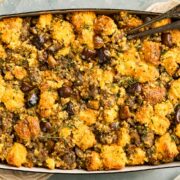
Chestnut Stuffing Recipe
Equipment
- 1 baking sheet (for toasting cornbread cubes)
- 1 large skillet (for sautéing chestnuts)
- 1 Measuring Cup (for whisking wet ingredients together)
- 1 8x11-inch Baking Dish (for baking the stuffing)
Ingredients
- 18 ounces Day-Old Cornbread – cut into ¾-inch cubes (about 8 cups)
- 8 ounces Roasted & Peeled Chestnuts - coarsely chopped (SEE NOTES) (about 1 1/2 cups)
- To Taste Kosher Salt & Ground Black Pepper - to taste
- 5 1/2 TBS Unsalted Butter - DIVIDED
- 1 small Yellow Onion – small dice (about 1 1/4 cup)
- 2 large Ribs Celery – small dice (about ¾ cup)
- 16 ounces Pork Sausage (SEE NOTES)
- 2-3 cloves Garlic - minced, to taste
- 1 heaping TBS fresh Thyme Leaves – finely chopped
- 2 heaping TBS fresh Flat Leaf Parsley – finely chopped
- 1 heaping TBS fresh Rosemary Leaves – finely chopped
- 1 1/2 - 2 Cups Reduced-Sodium Chicken Stock - DIVIDED
- 2 large Eggs
- Optional Garnishes: Fresh Herbs (parsley and/or thyme)
Instructions
- Preheat Oven: Arrange your oven rack to the middle position and then preheat the oven to 400-degrees F.
- Toast cornbread: Spread the cubed cornbread out evenly onto a large baking sheet. Transfer to the preheated oven and bake until the cubes of bread are golden and lightly toasted all over, about 8-10 minutes. Remove the cornbread from oven and allow to cool completely.
- Decrease Oven and Prep Baking Dish: Decrease the oven temperature to 350 degrees F. Next, grease an 8x11’’ baking dish with non-stick cooking spray or butter and then set it aside.
- While the Cornbread Toasts, Saute the Chestnuts: Melt 1 ½ tablespoons of butter in a large skillet or Dutch oven over medium heat. Once the butter is melted, add the chopped chestnuts to the pan and season with salt and pepper. Cook the chestnuts, stirring often, until they're fragrant and golden in color, about 5 minutes. Then, use a slotted spoon to remove the chestnuts from the skillet and transfer them to a large mixing bowl. Use a paper towel to wipe the skillet out before proceeding with the recipe.
- Sauté Vegetables: In the same skillet, melt 2 tablespoons of butter over medium heat. Once melted, add the onions and celery to the pan and then season generously with salt and pepper. Sweat the vegetables, stirring often, for about 4-5 minutes or until softened.
- Add the Sausage: Add the sausage to the pan and season with a pinch of salt and pepper. Cook the sausage, using the back of a wooden to break it up into bite-sized pieces, for about 4-5 minutes or until the sausage begins to brown. Add Garlic: Add the garlic to the pan and sauté until fragrant, about 30-45 seconds. Add Fresh Herbs: To the pan, stir in the thyme, parsley, and rosemary. Cook until fragrant, about 1 minute. Remove from Heat, Add 1/2 Cup Stock: Remove the pan from heat and stir in ½ cup of stock. Then, transfer the sausage mixture to the mixing bowl with the chestnuts.
- Whisk Wet Ingredients: In a large measuring cup, whisk together 1 cup of chicken stock with all eggs. Whisk until well combined.
- Pour Egg Mixture over Sausage Mixture, then Add Toasted Bread: Slowly pour the egg mixture evenly over the sausage mixture. Next, add the toasted cornbread cubes. Then, gently fold everything together until well combined, taking care not to mash the cornbread. (Tip: The mixture should look wet. If you like your stuffing really wet, add another tablespoon or two of stock, but be sure not to add too much or your stuffing will be soggy!)
- Bake Stuffing Covered: Transfer the stuffing mixture to the prepared baking dish. Cover with aluminum foil. Bake the chestnut stuffing, covered, for 30 minutes. (SEE NOTES IF MAKING IN ADVANCE.)Meanwhile, melt the remaining 2 tablespoons of butter in the microwave on 50% power or over low heat on the stovetop.
- Brush with Butter, Bake Stuffing Uncovered: Remove the partially baked stuffing from oven. Remove the aluminum foil and discard. Next, use a pastry brush to brush the top of the stuffing generously with melted butter. Then, return the chestnut stuffing to the oven and continue to bake, uncovered, for 20-30 minutes or until the stuffing is hot and the top is golden and crisp to the touch.
- Cool Slightly: Remove the stuffing from the oven and place the baking dish on a wire cooling rack. Let the stuffing with chestnuts cool for 5 minutes before garnishing and serving.
- Serve: Sprinkle fresh herbs over the top of the hot stuffing and enjoy immediately!
Notes
- Chestnuts: You can roast your own chestnuts or purchase roasted and peeled chestnuts. If roasting chestnuts yourself, skip step 4 (toasting chestnuts).
- To Roast Chestnuts: Preheat your oven to 450 degrees. Cut an ‘X’ into the round end of each chestnut. Place scored chestnuts on a rimmed sheet pan. Place sheet pan in the oven and add ¼ cup of water to the pan. Roast for 10 minutes or until shells easily peel back where you scored an ‘X’ into chestnuts. (Keep an eye on chestnuts to avoid burning them!) Remove chestnuts from the oven and let cool slightly 1-2 minutes, or until cool enough to handle. Peel chestnuts
- Sausage: You can use any sausage you prefer. I like to use sage flavored ground breakfast sausage. If you use sausage in casing, remove the sausage from the casing before proceeding with the recipe.
- To make chestnut dressing in advance, assemble the stuffing as directed in the recipe. Tightly cover the unbaked stuffing with aluminum foil or plastic wrap and store in the refrigerator for up to 2 days. When ready to bake, remove the stuffing from the refrigerator and allow to sit on the counter for 30 minutes to remove the chill. Bake as instructed in the recipe - please note, you may need to cook the stuffing for a little bit longer since you will be be starting with a cold dish.
- Freezing: Stuffing can be frozen for up to 1 month. (Be sure to use a freezer-safe, air-tight container).
Nutrition
Did you make this recipe?
Mention @nospoonnecessary on Instagram and tag it #nospoonnecessary!
©No Spoon Necessary. All images and content are under copyright protection. Please do not use any images without prior permission. Please do not republish this recipe without prior consent. If you want to reference this recipe, please do so by linking directly to this post.

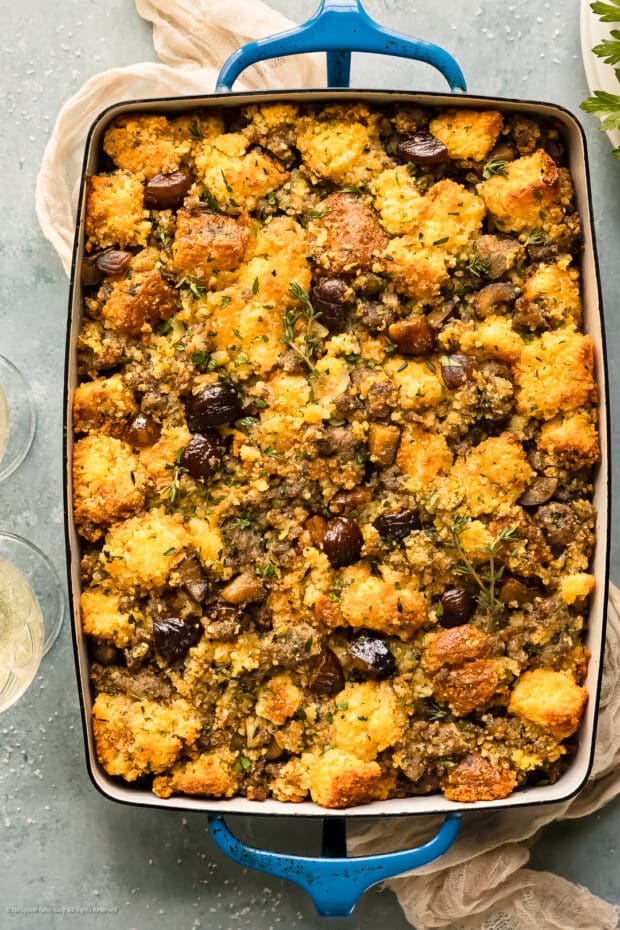
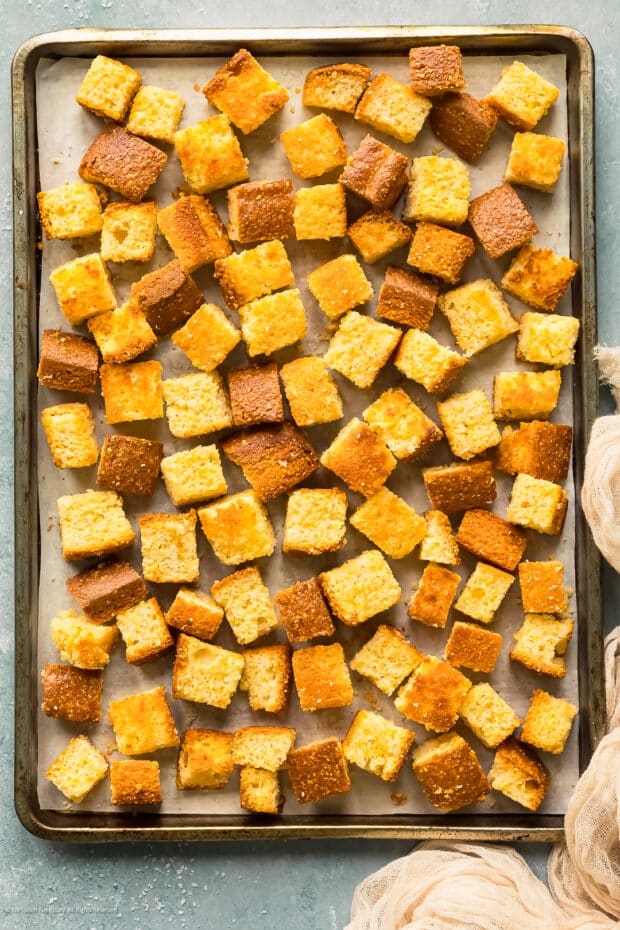
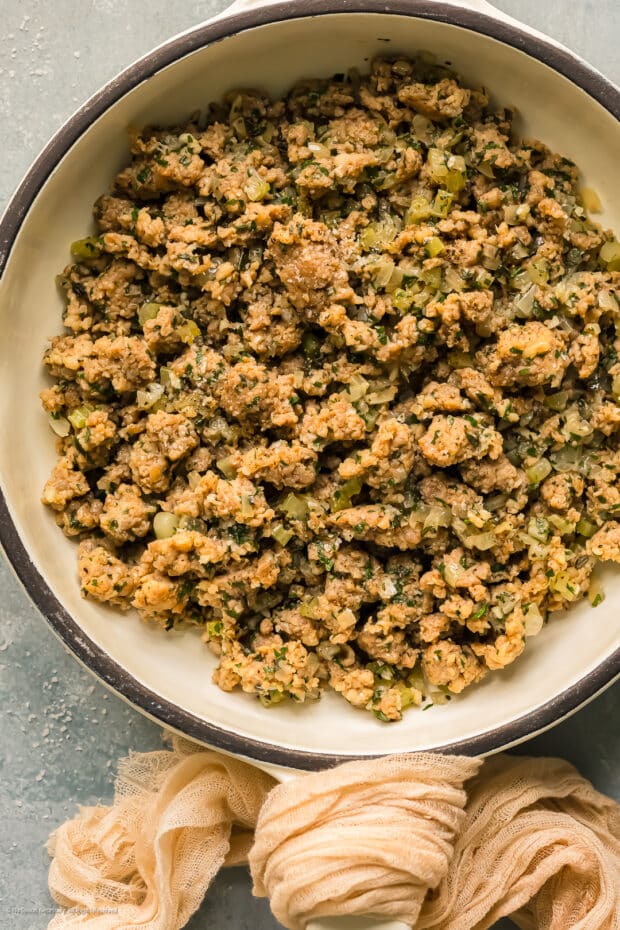
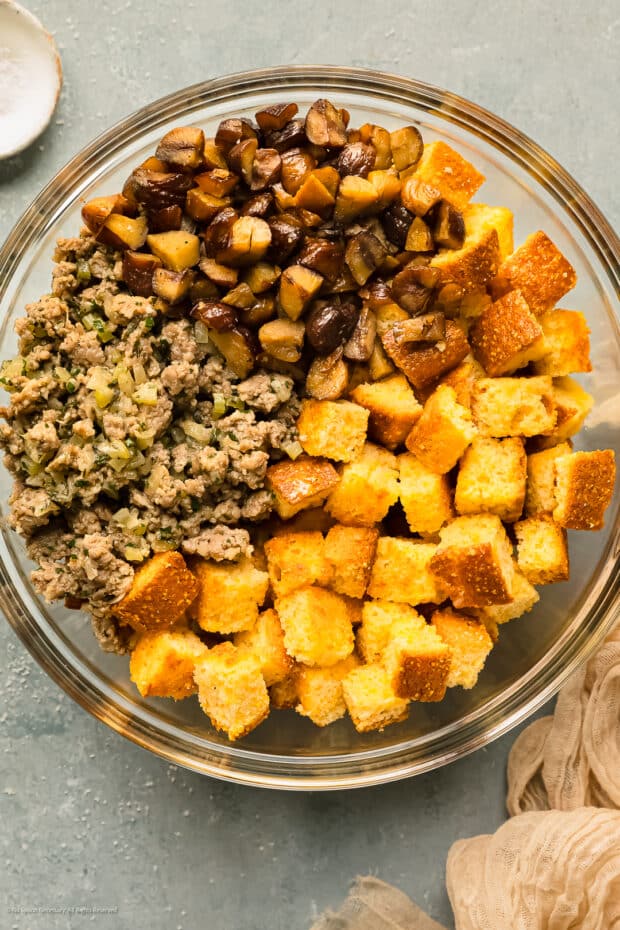
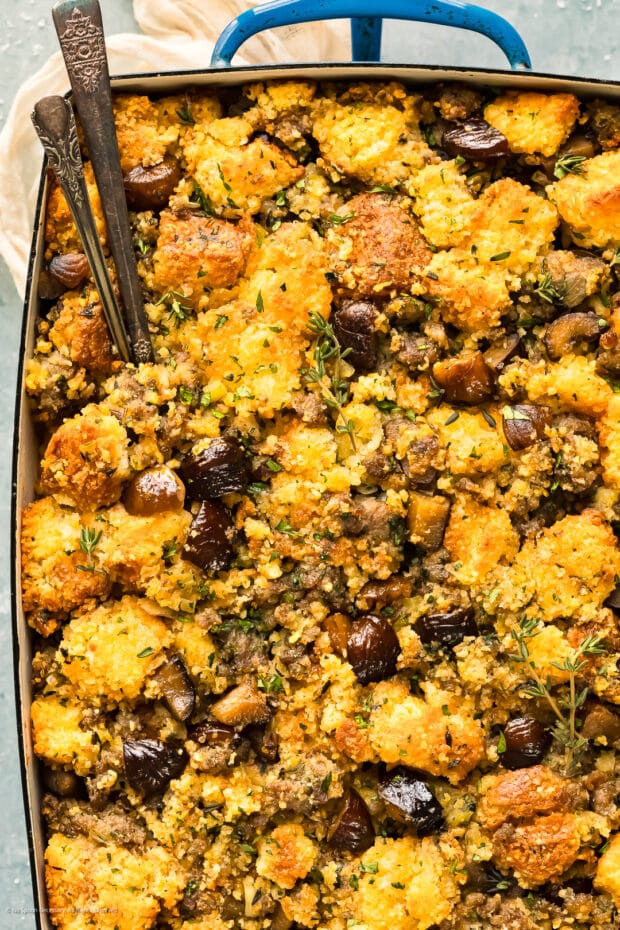
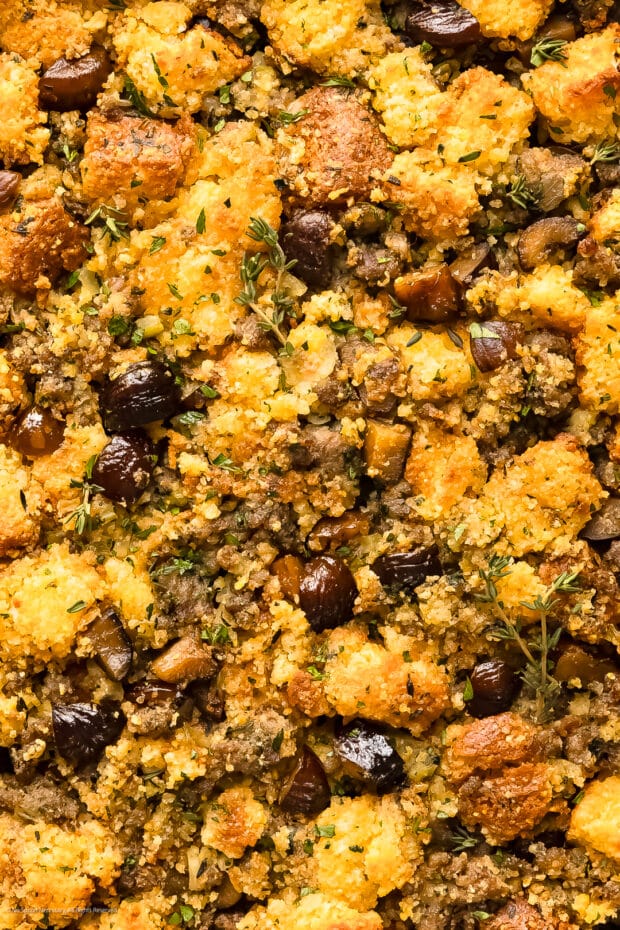
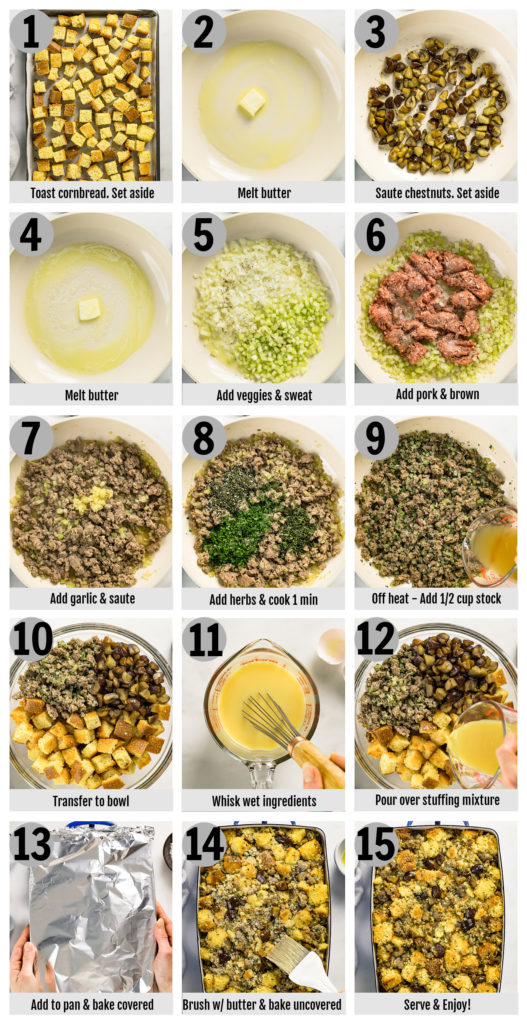
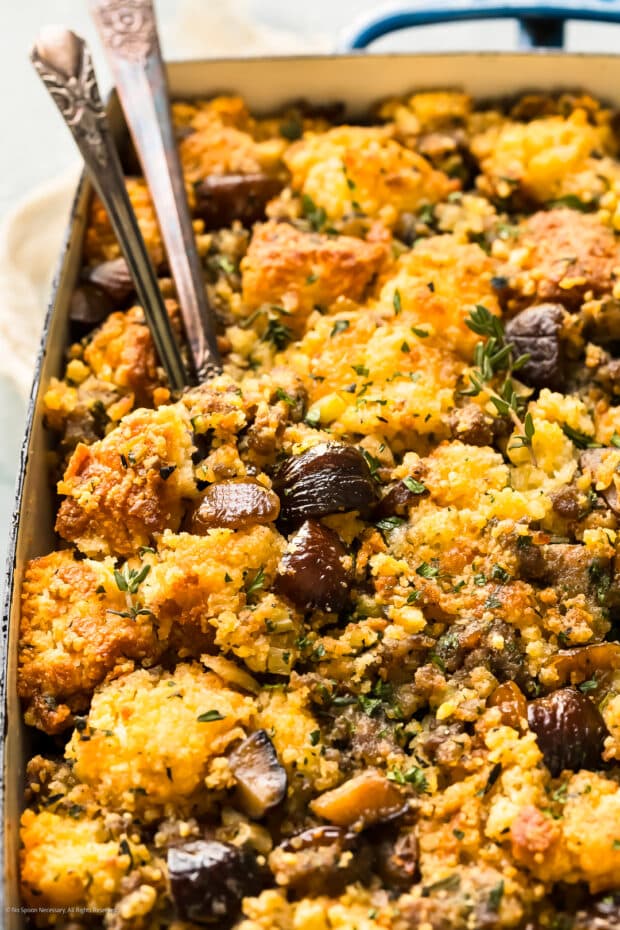
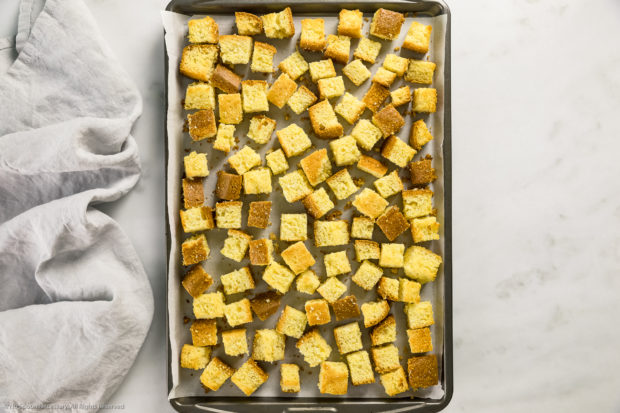
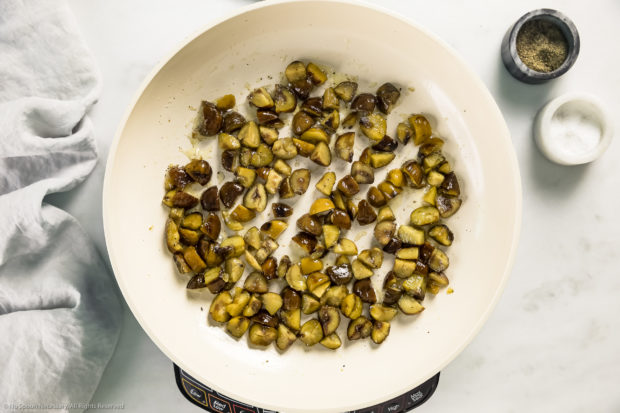
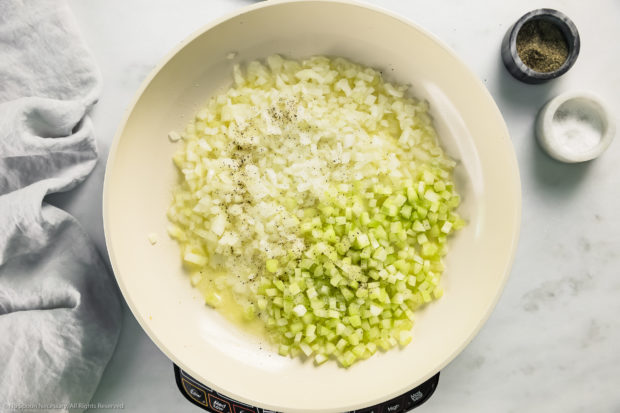
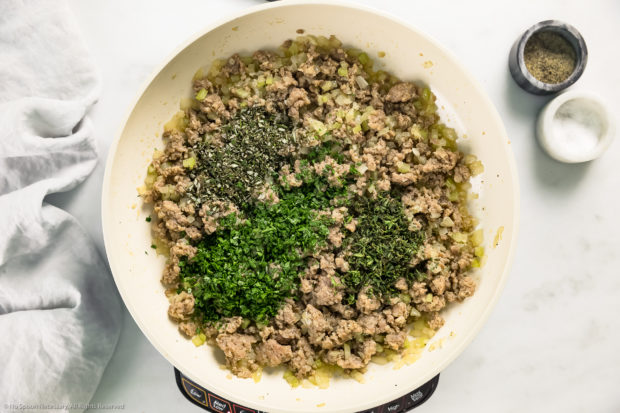
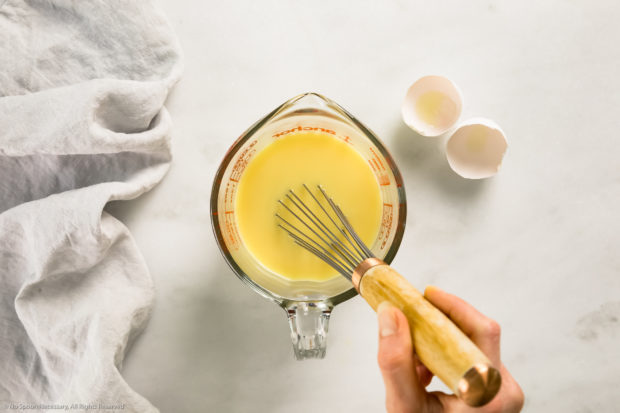
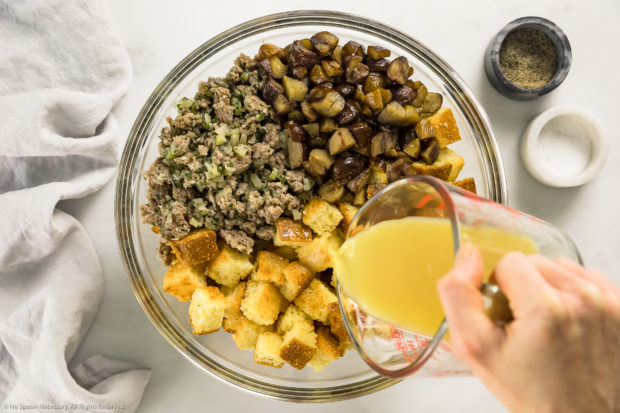
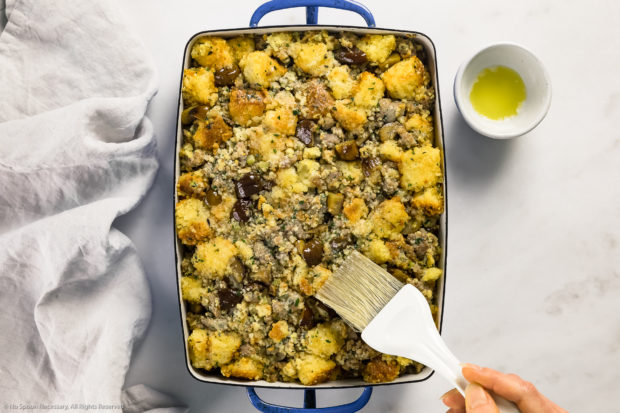
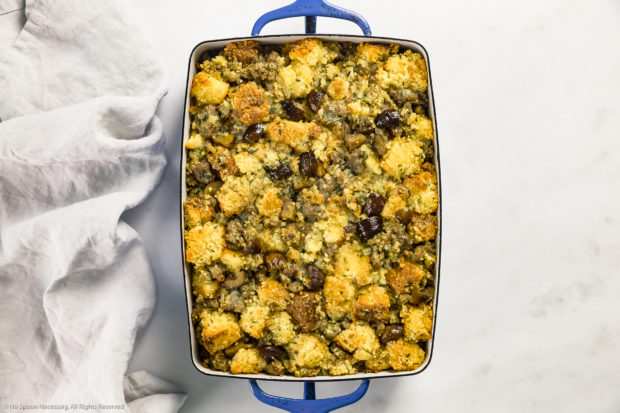
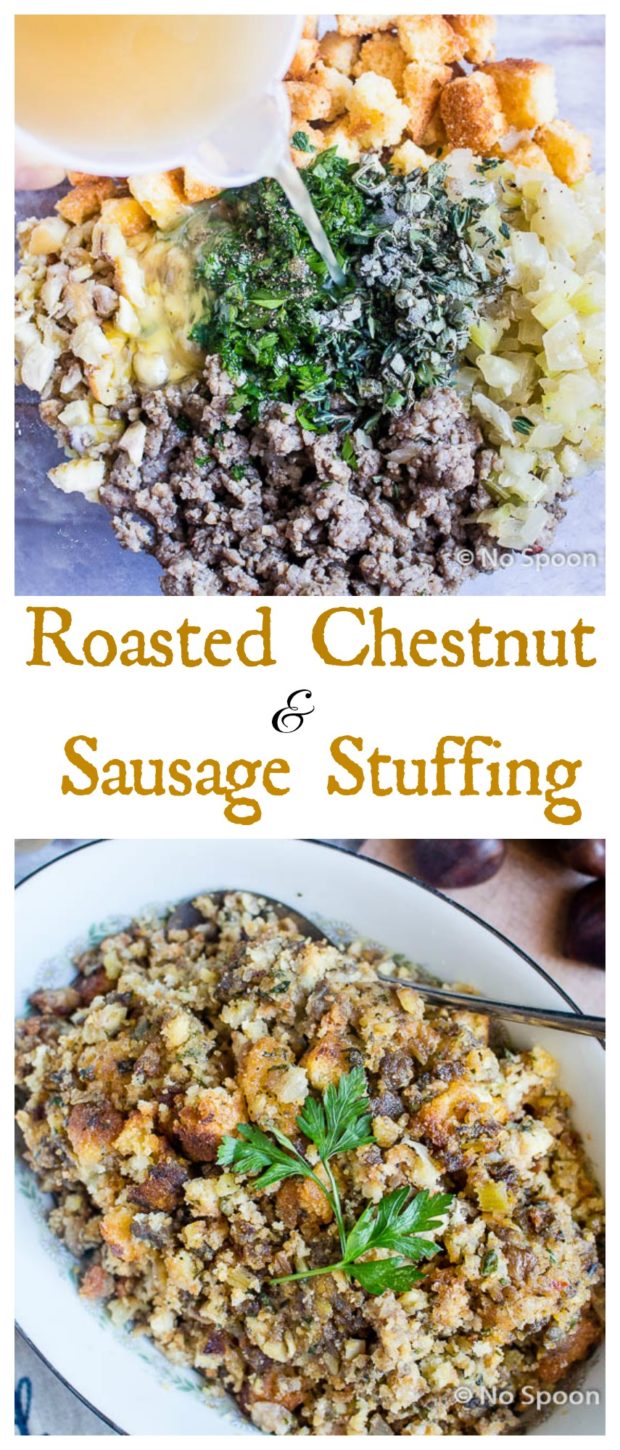
Jordan
Hey there! I have made this stuffing for three years in a row and it’s an all time favorite! However, this year I have not been able to find the sage sausage and to me that’s an amazing component. I bought normal sausage any ideas on how to infuse the sage flavoring in the sausage with normal sage? Or how much? Any tips would be awesome! Thank you!
Cheyanne
Hi Jordan!
First of all, I’m so honored you have made this stuffing three years in a row!!! Knowing that makes my holiday!!
Second, gosh, I’m so so sorry to hear you can’t find the sage sausage – although, unfortunately, I’m not shocked because I’ve had a difficult time sourcing a lot of things this year. But, man, that’s a bummer, because I agree – the sage sausage is a delicious component of this stuffing!
Anyways, I’d LOVE to help you in any way I possibly can!! Two key things here – Are you going to be using fresh or dried sage? And, how much sage flavor are you looking for? As for the amount, you could add 1 heaping tablespoon or more of fresh sage (finely mince) – depending how much sage flavor you are looking for. If you’re using dried, you will want to cut the amount by a third (so 1 tablespoon of fresh sage = 1 teaspoon of ground sage). If you are using fresh sage, you can add it to the sausage mixture when you add the other fresh herbs (step 5 of the recipe). If you are using dried ground sage, I would add it when you add the garlic (still step 5, but you will saute it a bit so it becomes aromatic).
My best advice, no matter whether you use fresh or dried, taste the sausage when you are done – before you add the stock. You can always add more sage, but you can never take it out! So if you like the flavor of sage, I’d start with 1 tablespoon fresh or 1 teaspoon dried – you can always stir in some more when you add the stock!
I feel like it’s worth noting: I’m fairly certain Jimmy Dean sage sausage also includes brown sugar, marjoram, red pepper flakes and cloves, so while your sausage might not taste identical, hopefully it’s close enough!! 🙂
Again, I’m so thrilled and honored my recipe has made it to your Thanksgiving dinner 3 years in a row!!! I hope you and your family have a beautiful holiday season! And, please, let me know if you have any other questions, I’m always more than happy to help!
Cary
This looks lovely. But I have a question: I only have time to use store bought cornbread (we have been on a long camping trip coming back late the day before Thanksgiving so no time to make my own). I find store bought cornbreads to be more on the sweet rather than savoury side. Do you think this will negatively affect the outcome? I plan to follow the instructions as directed otherwise. Thanks!
Cheyanne
Hi Cary,
Happy Thanksgiving! I hope you and your family had a lovely camping trip!
As for your question, I use store-bought cornbread for this stuffing whenever I’m in a pinch and have had no problem with the outcome of the stuffing. However (and this is a big however), I personally like the balance of the sweet cornbread and slightly sweet chestnuts with the savory sausage and earthy fresh herbs. If you don’t like sweet cornbread to begin with, you probably won’t like the finished stuffing, as the cornbread is one of the main ingredients – and you should never prepare or cook any dish with an ingredient you don’t like. Now, if you like a robust – sweet, savory and herbaceous – stuffing, then you will be fine to use store-bought cornbread. But, if you are looking for a strictly savory stuffing, my guess is you would be best served making your own cornbread for this recipe.
I hope I’ve answered your question!! If not, please let me know if you need more clarification or if I can be of any more assistance!!
Cheers and warm wishes for a wonderful Thanksgiving! 🙂
Erica
I am so excited to make this!! If I want to add sage, how much should I use? Thanks.
Cheyanne
Hi Erica,
Great question! Unfortunately, I have only tested and made the recipe as directed. Without knowing exactly what your taste is (how much you like sage) or what exactly you’re aiming for (a heavy sage flavor or just a touch of sage flavor), it’s hard to answer your question with any certainty. However, if I was going to add fresh sage, I would cut the rosemary in half (to 1 1/2 teaspoons) and add 1 1/2 teaspoons of fresh sage (finely chopped). Or, I would eliminate the rosemary entirely and substitute it with an equal amount of fresh sage (1 heaping tablespoon). If you love the taste of sage, you could go heavier handed, or you could also use sage flavored pork sausage in addition to the fresh sage.
I hope that answers your question, but please do let me know if you have any additional questions as I’m always happy to help!
I hope you love the stuffing as much as we do! Cheers and warm wishes for a wonderful holiday season! 🙂
Kelly
This stuffing is incredible! Those toasty, golden chunks of cornbread combined with the flavorful chestnuts, sausage and cornbread. This one will definitely be showing up again on my holiday table!
Gwen Enright
Cheyanne; my husband and I made this stuffing for Christmas this year. We’ve been married 7-1/2 years and previously combined my award winning chestnut stuffing with his fabulous sage stuffing since both families wanted their traditional stuffing. This year, I found your recipe and we followed your easy, pictures included, step by step instructions to the letter; the end result was the most amazing stuffing either of us has ever served. The reviews were, without exception, that this is the best stuffing we’ve ever made and, yes, lets do this from now one!! Thank you, Cheyanne, for providing us with a new family recipe that will undoubtedly tingle tastebuds at family gatherings for generations to come!
Cheyanne
Hi Gwen,
First of all, I am absolutely honored you decided to give my recipe a try and make it for your family’s Christmas gathering this year!!
I am so happy to hear you found the recipe easy to follow and beyond thrilled everyone enjoyed it!! Honestly, your kind comment has made my year! I am extremely grateful and privileged to have readers like you!! Thank you so much for coming back and letting me know how the stuffing went over!!
Warm wishes to both you and your family for a beautiful New Year!
All the best,
Cheyanne
Kayla
This is one of the most flavorful and aromatic dressings I have ever had for Thanksgiving, wonderful combinations of all those classic flavors but bursting with nuttiness!
Kelsy B
Um, you can send all of your husband’s stuffing my way because it’s my favorite! But, I can see why he likes this one–it’s absolutely amazing! And now I’m even more excited for Thanksgiving next year :). Thanks!
Angela
Seriously, I didn’t even need the turkey for Thanksgiving since I had this stuffing!!! Utterly delicious!
Maritza
So, I’ve never made stuffing before and am giving your recipe a try. I just roasted the chestnuts and burned them. 🙁 Will this recipe still be ok without the chestnuts? I’m making your turkey roulade stuffed with this recipe so I’m afraid omitting the chestnuts will mess everything up. :0
Cheyanne Bany
Hi Maritza! So sorry to hear you burned the chestnuts! If you have pecans on hand, they would make a suitable substition (don’t worry about roasting them). If you dont, I’d say just make the stuffing without it. You will be missing a flavorful component, but you should be fine! Let me know if you have any other questions! Cheers!!
Marissa
Yes, I’m also the lifelong victim of the combo holiday / birthday celebration…January baby. haha!
I’d never heard of cornbread stuffing before I married my husband. His parents are from the Memphis where I think everyone has cornbread instead of the bread stuffing. And it always has to have chestnuts.
We’re hosting the dinner at our house this year and I was JUST saying to Keith that I wanted to make their families traditional stuffing but with sausage added. And just lookee here – ta da!! Thanks, my friend!